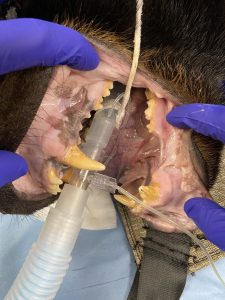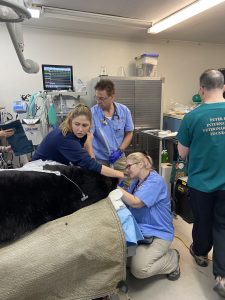What does a nearly 400-pound black bear do when he breaks a tooth?
Typically, if you’re a bear in the woods gnawing on a snack and you break a tooth—you have no options. You get to live with your gnarly tooth and pain for the rest of your life.
For Guignard, one of two Florida black bears at the Central Florida Zoo, that is not the case. Because of the observant Keeper team and help from animal dental specialists from across the country, our bear received a root canal for his left lower (mandibular) canine tooth to prevent a possible infection and keep his mouth healthy.
Here is the backstory: during a training session, a keeper noticed Guignard had a chipped tooth. At the time, the broken tooth did not seem to be bothering Guignard. Keepers continued to monitor his tooth, eating behaviors, and general attitude. 
After some time, through routine training sessions where Keepers ask Guignard to open his mouth, they noticed a change in the color of the tooth. The veterinary team was notified of the change along with Guignard’s changing interest in harder food items. Katrina Mishel, one of our veterinary technicians, initially mentioned the Peter Emily International Veterinary Dental Foundation as a possible source of help.
The Foundation provides pro-bono dental care to exotic animal sanctuaries and zoos in need.
Dr. Alex Mason (DVM, MS, CertAqV), an associate veterinarian with the Zoo, reached out to the Foundation, and they agreed to pay a visit. On a recent Saturday morning, Dr. Barron P. Hall (DVM, FAVD, DAVDC) who is a boarded-certified veterinary dentist, and Charles E. Dyer, IV, (DDS, MS) who is a human periodontal surgeon, worked together to perform a root canal on Guignard.
With our vet team, Keepers and the dentists working together, it was like watching a performance that had been done hundreds of times. It was clear that this well-orchestrated team of individuals absolutely loves animals. In less than an hour, Guignard received both a root canal and a general medical exam with tons of love and attention.
After the procedure, he was whisked back to his home for a successful recovery.
Root canals are not fun, whether you’re human or a bear. But the type of care our Florida black bear received showcases the fact that the quality of medical attention our population receives is vastly different than what they face in the wild.
Dr. Hall, who flew in from Virginia to lead the procedure, has worked on many types of animals, including other types of bears.
“The only bear I have yet to work on is the polar bear!’’ he said with a smile while touring the Zoo after the procedure.
Dr. Dyer noted, “It is fun to travel around and meet with Keepers and vet teams and work together for the betterment of animals.” Dyer is the president of the Foundation’s Board of Directors.
The traveling dentists have worked together often over the past decade helping all types of animals recover from dental issues. They bring all the equipment they need with them. In addition, they travel about two times a month to zoos and animal sanctuaries across the U.S. to help out animals in need.
The foundation relies soley on the financial support of generous donors to be able to provide these services to organizations, oftentimes with no direct cost to the organizations themselves. The dentists donate their time and equipment to the cause.
 Our Keeper team and veterinary crew did an outstanding job of making life easy for our visitors, from prepping Guignard for the root canal to carefully watching over the recovery. Working on a seven-foot, nearly 400-pound black bear might be daunting for some, but the good doctors from out of town and our team seemed to relish the challenge.
Our Keeper team and veterinary crew did an outstanding job of making life easy for our visitors, from prepping Guignard for the root canal to carefully watching over the recovery. Working on a seven-foot, nearly 400-pound black bear might be daunting for some, but the good doctors from out of town and our team seemed to relish the challenge.
Dr. Mason, who helped organize the visit, explained, “Guignard’s case is a great example of how zoos can collaborate with specialists to provide the highest quality of care for our animals. When an animal is kept in human care, we as an institution have a responsibility to ensure that we provide the best possible care to these animals. These types of procedures allow us to not only provide quality treatment to an animal promptly but to prevent future complications down the road and lead to an overall improved quality of life for the animal.’’
This is not the first time Guignard has received special treatment because of where he lives. His entire life is a story of conservation and beating the odds.
Guignard and his sister Ella were born in the wild but illegally removed by humans. They were found living in a home just over the state line and brought to the Zoo by the Florida Fish and Wildlife Conservation Commission (FWC) when they were just eight months old.
Because they were too accustomed to human contact, Ella and Guignard became permanent residents of the Zoo, educating those who live in bear communities about living with the species unique to the Sunshine State.
We’re happy to say that Guignard will be able to do just that again, happy and healthy. Thanks again to the team for making it possible!